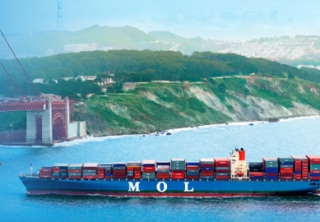 Mitsui O.S.K. Lines (MOL) has rolled out a new business management plan that will see its gradual shift of focus away from the challenging global ocean shipping industry to the more profitable LNG carrier and container terminal businesses.
Mitsui O.S.K. Lines (MOL) has rolled out a new business management plan that will see its gradual shift of focus away from the challenging global ocean shipping industry to the more profitable LNG carrier and container terminal businesses.
MOL president Koichi Muto introduced the company’s change of directions under its new “Steer for 2020” midterm strategy. The plan, which takes effect in April 2014, stresses a move away from the conventional model of controlling the impact of market changes to a new structure “where we can reap profits with certainty regardless of the market level.”
Koichi added, “By the end of fiscal year 2019, ending in March 2020, we are seeking a departure from conventional-type profit targets on the assumption of soaring market conditions. Instead, we will aim for high-quality, solid growth by offering added value to customers while unflinchingly meeting the challenge of providing high-level transport services.”
Specifically, Koichi, who spoke recently at the 130th anniversary celebration of the Japanese carrier, said, “we will reallocate management resources… and make a bold and rapid shift in our business portfolio toward LNG carrier and offshore businesses.”
Noting that while global ocean trade has improved in step with economic recovery and the imbalance between fleet supply and demand has narrowed slightly, “the market has yet to see structural improvements, due to a continuing overcapacity of shipbuilding facilities.”
In response, the company will “turn our eyes to expanding our business domain both upstream and downstream from ocean shipping transport.”
Ocean transport activities, meantime, will focus on building “a flexible fleet that has increased market tolerability,” enhancing vessel efficiency by combining trades, focusing on high-value-added cargo transport, and cutting costs.
“The containership segment is the key when it comes to achievement of our management goals,” said Koichi. “We will seek thorough cost rationalization to improve profitability while maintaining the investment needed to stay competitive, while making the most of strategic alliances.”
Under the plan, the company is aiming for a net income of JPY80 billion (US$774.86 million) in 2016 and JPY110 billion in 2019.




